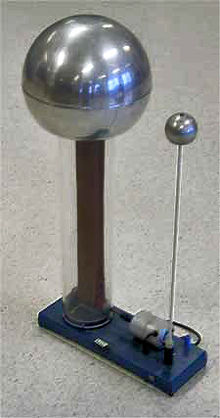 Small Van de Graaff generator used in science education | |
| Uses | Accelerating electrons to sterilize food and process materials, accelerating protons for nuclear physics experiments, producing energetic X-ray beams in nuclear medicine, physics education, entertainment |
|---|---|
| Inventor | Robert J. Van de Graaff |
| Related items | linear particle accelerator |
A Van de Graaff generator is an electrostatic generator which uses a moving belt to accumulate electric charge on a hollow metal globe on the top of an insulated column, creating very high electric potentials. It produces very high voltage direct current (DC) electricity at low current levels. It was invented by American physicist Robert J. Van de Graaff in 1929.[1] The potential difference achieved by modern Van de Graaff generators can be as much as 5 megavolts. A tabletop version can produce on the order of 100 kV and can store enough energy to produce visible electric sparks. Small Van de Graaff machines are produced for entertainment, and for physics education to teach electrostatics; larger ones are displayed in some science museums.
The Van de Graaff generator was originally developed as a particle accelerator for physics research, as its high potential can be used to accelerate subatomic particles to great speeds in an evacuated tube. It was the most powerful type of accelerator until the cyclotron was developed in the early 1930s. Van de Graaff generators are still used as accelerators to generate energetic particle and X-ray beams for nuclear research and nuclear medicine.[2]
The voltage produced by an open-air Van de Graaff machine is limited by arcing and corona discharge to about 5 MV. Most modern industrial machines are enclosed in a pressurized tank of insulating gas; these can achieve potentials as large as about 25 MV.
- ^ Van de Graaff, R. J.; Compton, K. T.; Van Atta, L. C. (February 1933). "The Electrostatic Production of High Voltage for Nuclear Investigations" (PDF). Physical Review. 43 (3): 149–157. Bibcode:1933PhRv...43..149V. doi:10.1103/PhysRev.43.149. Retrieved August 31, 2015.
- ^ Cassiday, Laura (July 10, 2014). "Hair-raising technique detects drugs, explosives on human body". Science. doi:10.1126/article.22861 (inactive 1 November 2024). Retrieved 10 May 2022.
{{cite journal}}: CS1 maint: DOI inactive as of November 2024 (link)